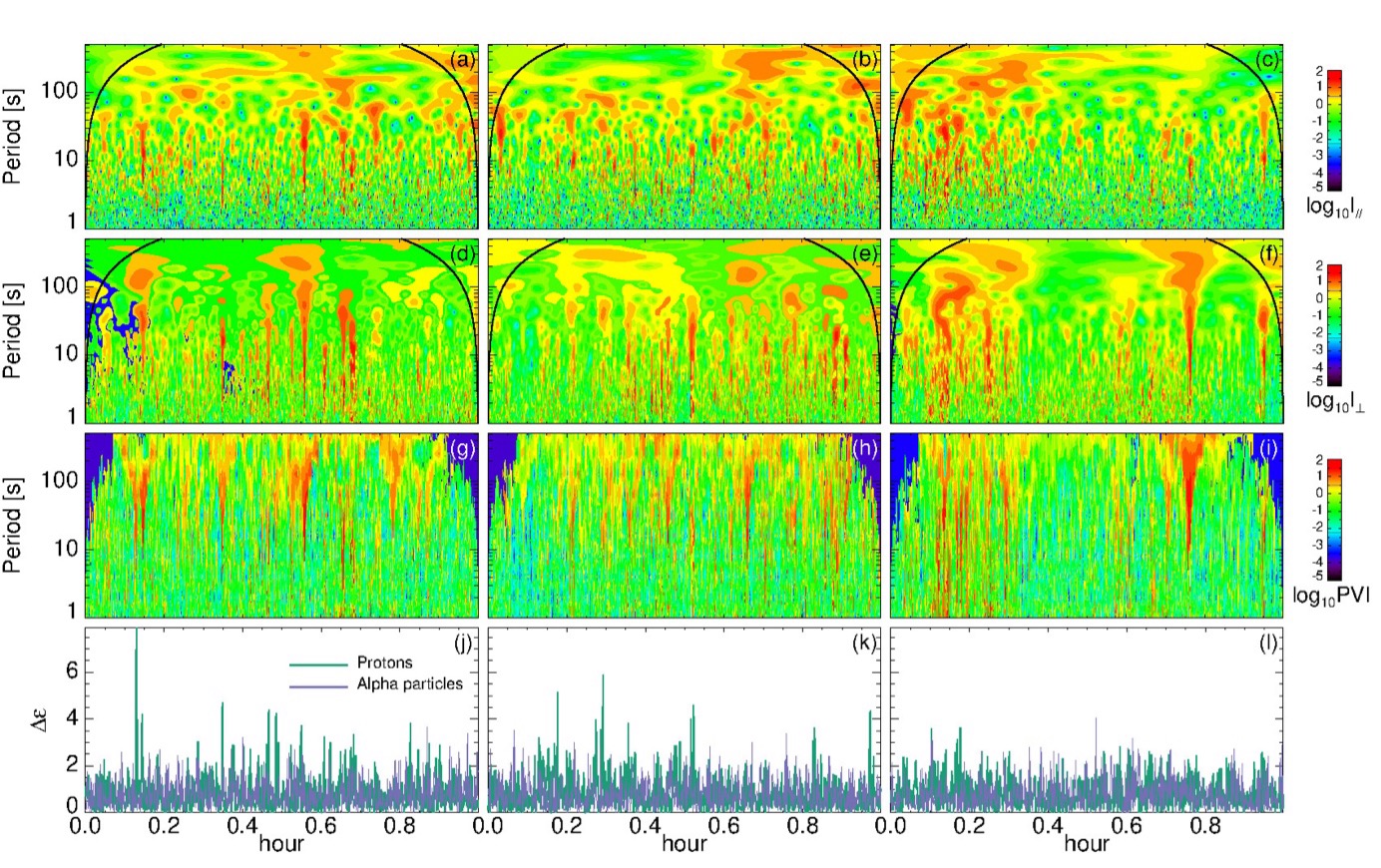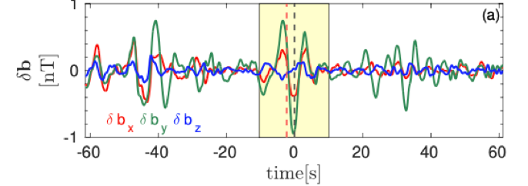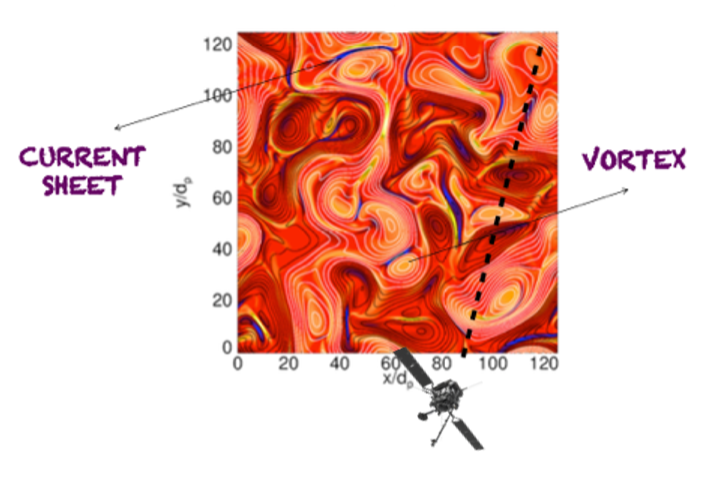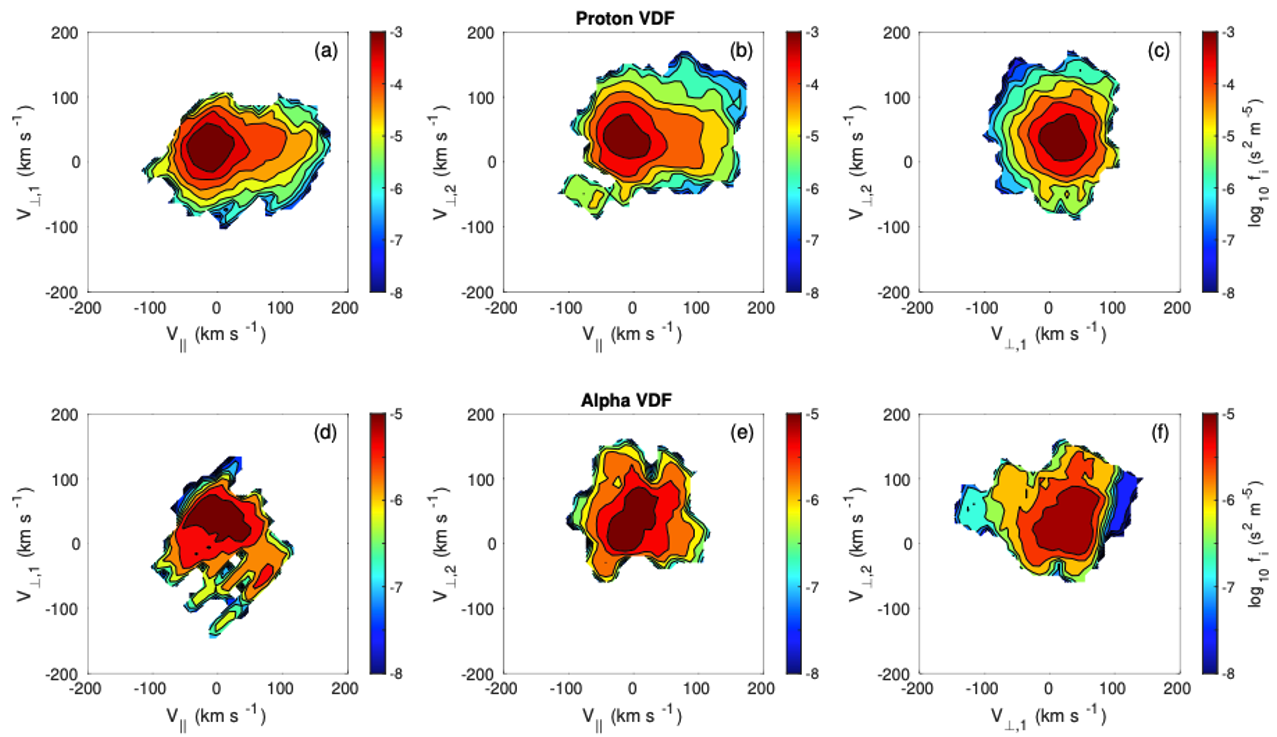Science nugget: Deformations in the velocity distribution functions of protons and alpha particles observed by Solar Orbiter in the inner heliosphere - Solar Orbiter
Deformations in the velocity distribution functions of protons and alpha particles observed by Solar Orbiter in the inner heliosphere
(Solar Orbiter Nugget #26 by D. Perrone1, A. Settino2, R. De Marco3, R. D’Amicis3, S. Perri4)
Introduction
The solar wind is observed to be turbulent [1]. Turbulence in plasmas involves a complex cross-scale coupling of fields, thus how the energy contained in the large-scale fluctuations of electromagnetic and velocity fields cascades all the way down to the kinetic scales, and how such turbulence interacts with particles, remain unsolved problems in plasma physics. Answering this problem will have strong implications for space [1,4], astrophysical [5,6], and laboratory plasmas [7]. The heliosphere, characterized by nonlinear processes, such as the generation of shocks, waves, coherent structures, magnetic reconnection and particle acceleration, represents the best natural laboratory to study in-situ plasma turbulence. The nature of the turbulent magnetic fluctuations around proton scales has been studied in the interval of slow Alfvénic wind observed by Solar Orbiter in July 2020 at 0.64 AU [8], with a particular attention to the link between the emergence of coherent events and kinetic effects on the proton and alpha particle velocity distribution functions (VDFs).
Solar Orbiter measurements
Solar Orbiter was launched in February 2020 and, during its cruise phase, it has been embedded for the first time in a slow Alfvénic solar wind stream at a radial distance of about 0.64 AU [8]. This stream is characterized by three well-defined plasma regions, namely a main portion, an intermediate region, and a rarefaction region. 1h intervals in each of those regions, with a very high Alfvénicity, have been selected and studied separately, in order to enhance similarities and differences in their turbulence properties. Coherent structures naturally emerge over different time/spatial scales and their characteristics at ion scales have been investigated.
Figure 1 shows the distribution of the magnetic energy in time and timescales, by means of two techniques, the local intermittency measure (LIM) [9], and the partial variance of increments (PVI) [10]. Localized (in time) channels in the PVI and LIM signals broaden over time scales, suggesting a magnetic energy cascade from large towards small time scales. Thus, this non uniform distribution of energy indicates the emergence of coherent structures [12-17]. They can be strongly related to the presence of kinetic effects, such as particle energization, temperature anisotropy, and deviation from Maxwellian VDF [18-20]. Therefore, the bottom panels of Figure 1 show the increments of the deviation of the proton and alpha VDF from the thermodynamic equilibrium, enhancing a link between the presence of strong intermittent events and the distortion of both proton and alpha particle VDFs.

Figure 1. Logarithmic contour plots of the local intermittency measure (LIM) of the parallel, I∥ (a–c), and perpendicular, I⊥ (d-f), magnetic field fluctuations, where curved lines, at each side of the plots, indicate the cone of influence. Logarithmic contour plots of the magnetic PVI (g-i). Dimensionless proton (green) and alpha particle (violet) increment of non-Maxwellianity parameter, Δε (j-l) [11].
Vortex chain
An in-depth investigation has shown that coherent structures are mainly current sheets and vortex-like structures. The latter can be found either isolated or grouped in chains. An example of a vortex chain is shown in panel (a) of Figure 2, where the components of the magnetic field fluctuations are shown in the local magnetic field frame, with the direction of the local magnetic field along the z-direction.
Numerical simulations have also shown that turbulence leads to the generation of current sheets and vortices, which evolve in time interacting nonlinearly among each other [see, e.g., 21 and 22]. For example, if a simulated Solar Orbiter spacecraft was allowed to travel within a kinetic simulation, sampling magnetic field data along a linear trajectory in the numerical box, it would cross discontinuities and magnetic islands, with the latter appearing as a vortex chain (see panel b of Figure 2).


Figure 2. Panel (a): Example of a vortex chain crossed by Solar Orbiter and centered at 03:27:56.58 UT (black vertical dashed line) on July 17th. Components of the magnetic field fluctuations in the local magnetic field reference frame, where b0 is along the z-direction. The yellow box marks the width of the central vortex. Adapted from [11]. Panel (b): Contour plot of the out-of-plane current density from a multi-ion hybrid Vlasov Maxwell simulation, where the black dashed line represents the trajectory of a virtual Solar Orbiter spacecraft in the numerical box. Adapted from [21].
Deformation of the ion VDFs
Coherent structures are generally connected to strong distortions in the ion VDFs, such as the presence of a secondary field-aligned beam. A quantitative indication of the degree of distortion in the 3D ion VDFs observed by Solar Orbiter [23] is provided by the increased non-Maxwellianity parameter in correspondence of such intermittent regions and strong discontinuities (see Figure 1).
Figure 3 shows 2D contour plots of both proton and alpha particle VDFs close to the center of the main vortex structure (red vertical dashed line in Figure 2). The VDF of each ion population (protons and alpha particles) is displayed in their respective rest frame and significantly deviates from thermodynamic equilibrium. Indeed, the proton VDF shows a clear and stable field-aligned beam, while it is gyrotropic in the plane perpendicular to the magnetic field. Moreover, interestingly, the alpha particle VDF shows an oblique beam, a feature that needs further investigation. The same kinetic features are observed in correspondence of the other two vortex structures detected right before and after the main one.

Figure 3. 2D contour plots of the reduced velocity distribution functions of protons (top) and alpha particles (bottom) plotted in the rest frame coordinate system and at 03:27:55.78 UT on July 17th (red vertical dashed line in Figure 2) [11].
This study has been published in Denise Perrone, et al. 2023, Frontiers in Astronomy and Space Sciences, 10, 1250219 https://doi.org/10.3389/fspas.2023.1250219
Acknowledgements
Solar Orbiter is a space mission of international collaboration between ESA and NASA, operated by ESA. Solar Orbiter Solar Wind Analyser (SWA) data are derived from scientific sensors which have been designed and created, and are operated under funding provided in numerous contracts from the UK Space Agency (UKSA), the UK Science and Technology Facilities Council (STFC), the Agenzia Spaziale Italiana (ASI), the Centre National d’Etudes SpaDales (CNES, France), the Centre National de la Recherche Scientifique (CNRS, France), the Czech contribution to the ESA PRODEX programme and NASA. DP, SP, and AS would like to acknowledge the International Space Science Institute (ISSI) for its support of the team “Unravelling solar wind microphysics in the inner heliosphere” dedicated in part to the analysis of Solar Orbiter data.
Affiliations
1 ASI—Italian Space Agency, Rome, Italy; denise.perrone@asi.it
2 Space Research Institute, Austrian Academy of Sciences, Graz, Austria
3 National Institute for Astrophysics, Institute for Space Astrophysics and Planetology, Rome, Italy
4 Dipartimento di Fisica, Università Della Calabria, Rende, Italy
References
[1] Bruno, R., and Carbone, V. 2016, ‘Turbulence in the solar wind’ in Lecture notes in physics (Berlin, Germany: Springer) https://doi.org/10.1007/978-3-319-43440-7
[2] Marsch, E., Rosenbauer, H., Schwenn, R., Muehlhaeuser, K. H., and Neubauer, F. M. 1982, JGR, 87, 35 https://doi.org/10.1029/JA087iA01p00035
[3] Marsch, E., Schwenn, R., Rosenbauer, H., et al. 1982, JGR, 87, 52 https://doi.org/10.1029/JA087iA01p00052
[4] Verscharen, D., Klein, K. G., and Maruca, B. A. 2019, Living Rev. Sol. Phys., 16, 5 https://doi.org/10.1007/s41116-019-0021-0
[5] Webb, G. M., Barghouty, A. F., Hu, Q., and le Roux, J. A. 2018, APJ, 855, 31 https://doi.org/10.3847/1538-4357/aaae6c
[6] Verscharen, D., Wicks, R. T., Alexandrova, O., et al. 2021, Exp. Astron., 54, 473 https://doi.org/10. 1007/s10686-021-09761-5
[7] White, T. G., Oliver, M. T., Mabey, P., et al. 2019, Nat. Commun., 10, 1758 https://doi.org/10.1038/s41467-019-09498-y
[8] D’Amicis, R., Bruno, R., Panasenco, O., et al. 2021, A&A, 656, A21 https://doi.org/10.1051/0004-6361/202140938
[9] Farge, M. 1992, Annu. Rev. Fluid Mech., 24, 395 https://doi.org/10.1146/annurev.fl.24.010192.002143
[10] Greco, A., Chuychai, P., Matthaeus, W. H., Servidio, S., and Dmitruk, P. 2008, GRL, 35, L19111 https://doi.org/10.1029/2008GL035454
[11] Perrone, D., Settino, A., De Marco, R., D’Amicis, R., and Perri, D. 2023, Front. Astron. Space Sci., 10, 1250219 https://doi.org/10.3389/fspas.2023.1250219
[12] Lion, S., Alexandrova, O., and Zaslavsky, A. 2016, APJ, 824, 47 https://doi.org/10.3847/0004-637X/824/1/47
[13] Greco, A., Perri, S., Servidio, S., Yordanova, E., and Veltri, P. 2016, APJL, 823, L39 https://doi.org/10.3847/2041-8205/823/2/L39
[14] Perrone, D., Alexandrova, O., Mangeney, A., et al. 2016, APJ, 826, 196 https://doi.org/10.3847/0004-637X/826/2/196
[15] Perrone, D., Alexandrova, O., Roberts, O. W., et al. 2017, APJ, 849, 49 https://doi.org/10.3847/1538-4357/aa9022
[16] Perrone, D., Bruno, R., D’Amicis, R., et al. 2020, APJ, 905, 142 https://doi.org/10.3847/1538- 4357/abc480
[17] Perrone, D., Perri, S., Bruno, R., et al. 2022, A&A, 668, A189 https://doi.org/10.1051/0004-6361/202243989
[18] Servidio, S., Valentini, F., Califano, F., and Veltri, P. 2012, PRL, 108, 045001 https://doi.org/10. 1103/PhysRevLett.108.045001
[19] Servidio, S., Chasapis, A., Matthaeus, W. H., et al. 2017, PRL, 119, 205101 https://doi.org/10. 1103/PhysRevLett.119.205101
[20] Sorriso-Valvo, L., Catapano, F., Retinò, A., et al. 2019, PRL, 122, 035102 https://doi.org10.1103/PhysRevLett.122.035102
[21] Perrone, D., Valentini, F., Servidio, S., Dalena, S., and Veltri, P. 2013, APJ, 762, 99 https://doi.org/10.1088/0004-637X/762/2/99
[22] Servidio, S., Valentini, F., Perrone, D., et al. 2015, JPP, 81, 325810107 https://doi.org/10. 1017/S0022377814000841
[23] De Marco, R., Bruno, R., Jagarlamudi, V. K., et al. 2023, A&A, 669, A108 https://doi.org/10.1051/0004-6361/202243719
- Removed a total of (21) style text-align:left;
- Removed a total of (12) style text-align:justify;
- Removed a total of (4) style margin:0;
Nuggets archive
2025
09/04/2025: Bursty acceleration and 3D trajectories of electrons in a solar flare
02/04/2025: Picoflare jets in the coronal holes and their link to the solar wind
19/03/2025: Radial dependence of solar energetic particle peak fluxes and fluences
12/03/2025: Analysis of solar eruptions deflecting in the low corona
05/03/2025: Propagation of particles inside a magnetic cloud: Solar Orbiter insights
19/02/2025: Rotation motions and signatures of the Alfvén waves in a fan-spine topology
12/02/2025: 'Sun'day everyday: 2 years of Solar Orbiter science nuggets that shed light on some of our star's mysteries
22/01/2025: Velocity field in the solar granulation from two-vantage points
15/01/2025: First joint X-ray solar microflare observations with NuSTAR and Solar Orbiter/STIX
2024
18/12/2024: Shocks in tandem : Solar Orbiter observes a fully formed forward-reverse shock pair in the inner heliosphere
11/12/2024: High-energy insights from an escaping coronal mass ejection
04/12/2024: Investigation of Venus plasma tail using the Solar Orbiter, Parker Solar Probe and Bepi Colombo flybys
27/11/2024: Testing the Flux Expansion Factor – Solar Wind Speed Relation with Solar Orbiter data
20/11/2024:The role of small scale EUV brightenings in the quiet Sun coronal heating
13/11/2024: Improved Insights from the Suprathermal Ion Spectrograph on Solar Orbiter
30/10/2024: Temporally resolved Type III solar radio bursts in the frequency range 3-13 MHz
23/10/2024: Resolving proton and alpha beams for improved understanding of plasma kinetics: SWA-PAS observations
25/09/2024: All microflares that accelerate electrons to high-energies are rooted in sunspots
25/09/2024: Connecting Solar Orbiter and L1 measurements of mesoscale solar wind structures to their coronal source using the Adapt-WSA model
18/09/2024: Modelling the global structure of a coronal mass ejection observed by Solar Orbiter and Parker Solar Probe
28/08/2024: Coordinated observations with the Swedish 1m Solar Telescope and Solar Orbiter
21/08/2024: Multi-source connectivity drives heliospheric solar wind variability
14/08/2024: Composition Mosaics from March 2022
19/06/2024: Coordinated Coronal and Heliospheric Observations During the 2024 Total Solar Eclipse
22/05/2024: Real time space weather prediction with Solar Orbiter
15/05/2024: Hard X ray and microwave pulsations: a signature of the flare energy release process
01/02/2024: Relativistic electrons accelerated by an interplanetary shock wave
11/01/2024: Modelling Two Consecutive Energetic Storm Particle Events observed by Solar Orbiter
2023
14/12/2023: Understanding STIX hard X-ray source motions using field extrapolations
16/11/2023: EUI data reveal a "steady" mode of coronal heating
09/11/2023: A new solution to the ambiguity problem
02/11/2023: Solar Orbiter and Parker Solar Probe jointly take a step forward in understanding coronal heating
25/10/2023: Observations of mini coronal dimmings caused by small-scale eruptions in the quiet Sun
18/10/2023: Fleeting small-scale surface magnetic fields build the quiet-Sun corona
27/09/2023: Solar Orbiter reveals non-field-aligned solar wind proton beams and its role in wave growth activities
20/09/2023: Polarisation of decayless kink oscillations of solar coronal loops
23/08/2023: A sharp EUI and SPICE look into the EUV variability and fine-scale structure associated with coronal rain
02/08/2023: Solar Flare Hard Xrays from the anchor points of an eruptive filament
28/06/2023: 3He-rich solar energetic particle events observed close to the Sun on Solar Orbiter
14/06/2023: Observational Evidence of S-web Source of Slow Solar Wind
31/05/2023: An interesting interplanetary shock
24/05/2023: High-resolution imaging of coronal mass ejections from SoloHI
17/05/2023: Direct assessment of far-side helioseismology using SO/PHI magnetograms
10/05/2023: Measuring the nascent solar wind outflow velocities via the doppler dimming technique
26/04/2023: Imaging and spectroscopic observations of EUV brightenings using SPICE and EUI on board Solar Orbiter
19/04/2023: Hot X-ray onset observations in solar flares with Solar Orbiter/STIX
12/04/2023: Multi-scale structure and composition of ICME prominence material from the Solar Wind Analyser suite
22/03/2023: Langmuir waves associated with magnetic holes in the solar wind
15/03/2023: Radial dependence of the peak intensity of solar energetic electron events in the inner heliosphere
08/03/2023: New insights about EUV brightenings in the quiet sun corona from the Extreme Ultraviolet Imager








































 Sign in
Sign in
 Science & Technology
Science & Technology